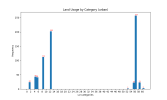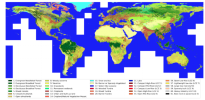Dear WRF experts!
I am stuck running WRF urban using the cglc-modis-lcz_100m dataset for Germany using three one-way nested domains at 12, 3, and 1 km, respectively. I'm considering the sf_urban_physics = 2 and the hybrid 100-m global land cover dataset with Local Climate Zones. To use this dataset, I followed the instructions provided here, which include changing the geog_data_res in namelist.wps as follows:
geog_data_res = 'cglc_modis_lcz+default', 'cglc_modis_lcz+default', 'cglc_modis_lcz+default'
I changed the GEOGRID.TBL.ARW_LCZ accordingly.
Also, I downloaded the dataset from the WPS V4 Geographical Static Data Downloads Page. Geogrid.exe, ungrib.exe, and metgrid.exe work fine, so does real.exe.
However, when I run wrf.exe, I get suspicious warnings in the rsl.error.0000 claiming that WRF does not use the LCZ data:
WARNING, FRC_URB2D = 0 BUT IVGTYP IS URBAN
WARNING, THE URBAN FRACTION WILL BE READ FROM URBPARM.TBL
USING DEFAULT URBAN MORPHOLOGY
I attached the namlist.wps, namlist.input and the rsl.error.0000 file.
Additionally, I uploaded a folder called "wrf_physics_lcz_Germany.zip" to the nextcloud that contains geo_em and met_em files and the Geogrid tbl (plus the files attached below).
I am using WRF 4.5.2 and WPS 4.5 and ensured that for both of them I am using official releases as you suggested in this post.
Can you see what the problem is? What did I miss?
Thank you very much for your help!
Best,
Lisa
I am stuck running WRF urban using the cglc-modis-lcz_100m dataset for Germany using three one-way nested domains at 12, 3, and 1 km, respectively. I'm considering the sf_urban_physics = 2 and the hybrid 100-m global land cover dataset with Local Climate Zones. To use this dataset, I followed the instructions provided here, which include changing the geog_data_res in namelist.wps as follows:
geog_data_res = 'cglc_modis_lcz+default', 'cglc_modis_lcz+default', 'cglc_modis_lcz+default'
I changed the GEOGRID.TBL.ARW_LCZ accordingly.
Also, I downloaded the dataset from the WPS V4 Geographical Static Data Downloads Page. Geogrid.exe, ungrib.exe, and metgrid.exe work fine, so does real.exe.
However, when I run wrf.exe, I get suspicious warnings in the rsl.error.0000 claiming that WRF does not use the LCZ data:
WARNING, FRC_URB2D = 0 BUT IVGTYP IS URBAN
WARNING, THE URBAN FRACTION WILL BE READ FROM URBPARM.TBL
USING DEFAULT URBAN MORPHOLOGY
I attached the namlist.wps, namlist.input and the rsl.error.0000 file.
Additionally, I uploaded a folder called "wrf_physics_lcz_Germany.zip" to the nextcloud that contains geo_em and met_em files and the Geogrid tbl (plus the files attached below).
I am using WRF 4.5.2 and WPS 4.5 and ensured that for both of them I am using official releases as you suggested in this post.
Can you see what the problem is? What did I miss?
Thank you very much for your help!
Best,
Lisa
Attachments
Last edited:




